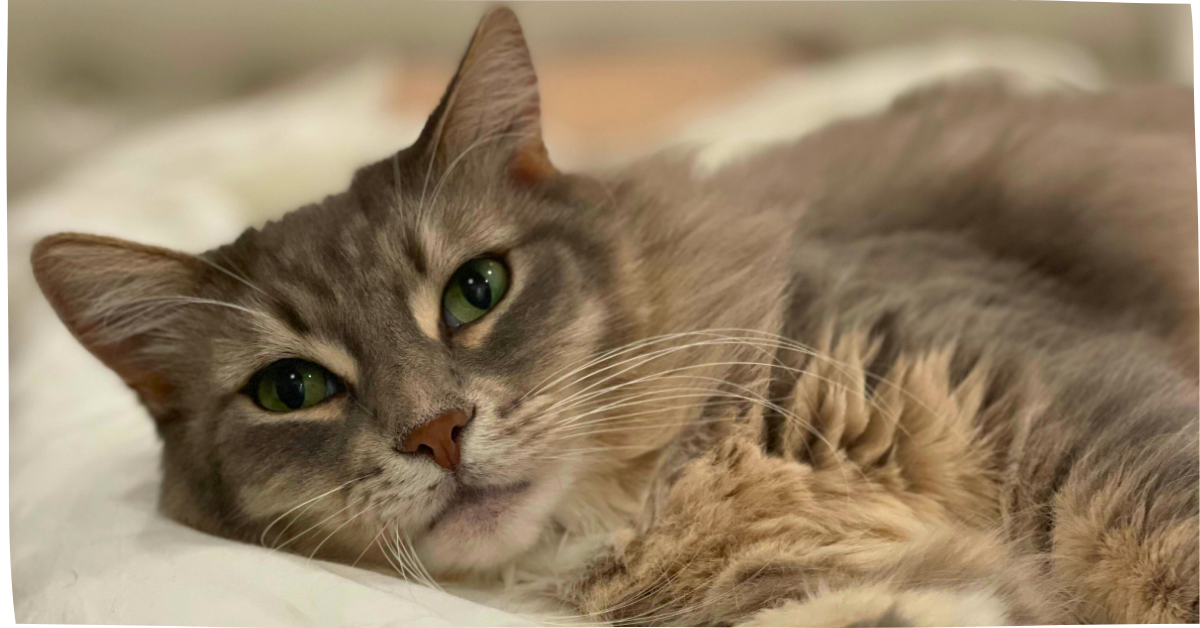What started as a routine dental for Elbee became a working diagnosis of Chronic Kidney Disease.
Let’s start with the story of Elbee.
Our girl Elbee, aka Sweet Belbert, Princess Elbee, Lovebug, joined our family in March 2016. At that point, we were just a family of three–Sid, our O.G. cat Poohkins, and me. Poohkins had adopted Sid and me a little less than a year prior, and we were having a great time together. But, for some reason, I thought Poohkins needed a friend.
I was wrong.
Poohkins was VERY happy being an only child.
We met Elbee, then named Zelda, in the adoption center of our local Petsmart. She was about six or seven months old, and we’d been told that her previous owner had to give up her cats due to a cancer diagnosis. What was an absolutely terrible moment for this woman turned into a wonderful one for us.
This little tricolor tabby was a social butterfly. We witnessed her welcome a new cat into the adoption center with head butts and an exposed belly. Her loud purrs and dramatic, attention-craving flops on the floor helped add to our certainty that she was the right girl to bring home to Poohkins.
Yes, we’d read all about adding a second cat to the household.
Cat experts recommend that the second cat is of the opposite sex and that the introduction process be gradual, including plenty of scent swapping.
We had also heard that temperament is more important than sex and that cats could get along with the proper introductory process.
What we thought would be a couple of weeks of introduction turned into four months of, “Oh my gosh, what have we done?”

We tried the infamous scent swapping along with baby gates, feeding them behind closed doors, inviting a cat behaviorist into our home, and more. Every time we tried a step forward, we returned to the beginning of the introductory process due to setbacks. I realized that my dream of these two cuddling together by the fireplace was most likely just a dream. Our goal became one of tolerating. Can these two live in the same space? And that’s what happened. Now, almost nine years later, our two girls coexist with one another along with their feline and canine siblings.
The Diagnosis
So our vet informed us this past November that Elbee was due for a routine dental. Their protocol is to do bloodwork to check the cat’s health on the morning of the appointment. If all is clear, the dentist proceeds. During the check-up appointment in which we were informed of the need for a teeth cleaning, I told our wonderful vet that Elbee had been drinking more water than normal. She also was urinating more, had appeared somewhat depressed, and she’d lost about two pounds since her last yearly exam. Because of this, our vet added a urinalysis along with the bloodwork.
Elbee’s morning of tests showed elevated BUN and Creatinine levels, prompting the first mention of Chronic Kidney Disease. Since that day, we’ve run additional blood and urine samples, and they are showing the same.
What is Chronic Kidney Disease? Basically, the kidneys stop filtering waste as they should. It’s a progressive condition with four stages, most commonly affecting senior cats. It’s estimated that 30-40% of cats over age 10 and 81% of cats over 15 have CKD.
We were told that changing her food to a low-phosphorus diet was the best thing we could do for her right now. Several pet food companies carry prescription and non-prescription CKD formulas in wet and dry varieties. We started with some Hill’s CKD wet food since our vet has this brand available. It was a no-go. Elbee didn’t care for any of the flavors or textures I presented. We then tried the Weruva low-phosphorus formulas and struck out again.
Since I make food for my dogs, I started searching around for homemade CKD food options. I came across several “vet-approved” recipes that were primarily carbohydrate-based. I’ve always understood that cats were obligate carnivores, so I didn’t understand why these foods contained more starches than proteins. I guess some earlier kidney care research suggested that the protein level in food for CKD cats should be reduced. However, this finding seems to have been reversed in more recent research.
So, I’ve decided to try making homemade food for Elbee and her feline siblings. I’m basing our recipe on this raw diet recipe I found. On top of the fish oil included in the recipe, I’m adding a vitamin supplement and extra Taurine. Our vet is concerned about a raw diet, so I will gently cook this ingredients and see how our cats like it. I’ll let you know!!
The other suggestion from our vet was to give Elbee weekly fluids. Ugh…. We previously faced this task when Franklin had some urinary crystal issues, and he decided that our floors were superior to the five litter boxes we lovingly provide. Administering subcutaneous fluids at home is not fun for anyone involved. It required scruffing, or pinching, his neck skin and inserting a reasonably large needle into the cat’s back. For Frank’s comfort, I set up a heating pad on our bathroom counter because the room temperature fluids can make the cat cold and uncomfortable, possibly cutting the time needed for 200 ml to enter the body. For my post-fluid comfort, I set up a rocks glass and a bottle of whiskey.
We plan to start fluids for Elbee this weekend. I’ll let you know how it goes.
In the meantime, if you have experience with feline CKD, please feel free to share your thoughts! I know there’s a lot of great advice out there.

